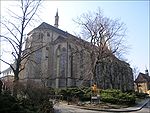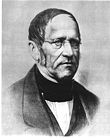
Orthographia bohemica
Encyclopedia
De orthographia bohemica (On Bohemian Orthography) is an anonymously-authored Latin work from the early 15th century, in which the Czech language
was given a codified spelling.
The reformer Jan Hus
is often suspected to be the work's author.
 Neither the author's identity nor the precise date of authorship are known. It has been proposed that the author is most likely Jan Hus
Neither the author's identity nor the precise date of authorship are known. It has been proposed that the author is most likely Jan Hus
and the year of creation somewhere between 1406 and 1412, based on historical and philological studies.
and trigraphs, it proposed a "diacritic orthography", where one letter indicates only one sound, and different but related sounds (such as those now represented by r and ř) are distinguished by diacritics. Briefly, one can summarize the spelling changes in Orthographia Bohemica as follows:
To illustrate the simple and revolutionary nature of this spelling, take as an example the various ways of representing ř, compared with that seen in the grammar of Jan Gebauer
. In manuscripts written before Hus, all of the following representations were in use: rz, rrz, rs, rzs, rzss, zr, sr, rzs and rzz. Long vowels were written either with no indication of the length, or written double (sometimes with the second letter written in superscript), or with any of a wide and unstandardised range of diacritical marks. One could not even assume that the same scribe would consistently use their own conventions, and their use often varied even within a single manuscript.
 Orthographia bohemica was the first known document in which such spelling reform
Orthographia bohemica was the first known document in which such spelling reform
s were suggested for a Slavic language. It is not yet fully clear where Jan Hus (if indeed he was the author) drew inspiration for this work. Considered in the context of the contemporaneous study of letters of St. Jerome by Danish scholars of Hebrew working at the Sorbonne
, there was a good knowledge of such orthographic practices at the time (particularly the designation of long vowels). According to a study by F. V. Mareš, a stimulus for the project was the author's knowledge of Glagolitic, used by Croatian
monks in the Emmaus Monastery (Na Slovanech) in Prague
.
The significance of the document lies in the longevity and wide application of the logical system of accents. The spelling of the period in which it was written was not universally accepted. Change occurred up to the introduction of the book, particularly apparent in the issue of the so-called Náměšťské grammar in 1533; scribes, however adopted changes much more slowly than in printed books. Even in the 16th century, some printers and typesetters ignored the prescriptions of Orthographia bohemica and continued to maintain some digraphs (eg ss for /ʃ/ instead of š), but their use was considerably more uniform than before.
 The manuscript for Orthographia bohemica was found by František Palacký
The manuscript for Orthographia bohemica was found by František Palacký
on 13th. August 1826 in Třeboň
in the south of Bohemia. The public was made aware of the existence of the work a year later, with the first issue of the newly founded journal Časopisu společnosti vlastenského Museum v Čechách ("Journal of the Society of the National Museum in Bohemia"), but its publication had to wait a further thirty years. The Latin text with translation appeared in 1857 in Slavische Bibliothek in Vienna thanks to A. V. Šember, who worked at the time at the university as Professor of Czech Language and Literature. A year later in Prague, the fifth volume of Mistra Jana Husi sebraných spisů ("Collected works of the master Jan Hus") appeared with a Czech translation and a short introduction by Václav Flajšhans, to date the latest Czech translation of this manuscript. The Latin text was published twice more: firstly the unaltered Šember translation in a new edition from Slavische Bibliothek (Amsterdam 1965), the second with German translation and commentary published in Wiesbaden in 1968 by of J. Schröpfer.
Šember's Latin text was probably taken directly from Palacký's copy of the manuscript; Schröpfer then submitted a new revised (though not flawless) publication of the manuscript. A critical evaluation comparing the preserved the Třeboň manuscript with the extant excerpts has still not released.
 A manuscript of Orthographia bohemica in Jan Hus' hand has still not been found; the only complete copy of the manuscript which is available for study was written by a monk Oldřich Kříž of Třeboň (i.e. the copy found by Palacký). Its age can not be accurately determined as the copy is not dated; only at the end is written In die Leonardi, i.e. on January 6, however this may indicate either the date of completion of the original manuscript, or Oldřich Kříž's copy. In the same volume as Orthographia bohemica, however, are some more works: three of them bear the year 1459 and one 1457. The writings are not arranged chronologically however, and so they serve only as an approximate guide for determining the age of the manuscript.
A manuscript of Orthographia bohemica in Jan Hus' hand has still not been found; the only complete copy of the manuscript which is available for study was written by a monk Oldřich Kříž of Třeboň (i.e. the copy found by Palacký). Its age can not be accurately determined as the copy is not dated; only at the end is written In die Leonardi, i.e. on January 6, however this may indicate either the date of completion of the original manuscript, or Oldřich Kříž's copy. In the same volume as Orthographia bohemica, however, are some more works: three of them bear the year 1459 and one 1457. The writings are not arranged chronologically however, and so they serve only as an approximate guide for determining the age of the manuscript.
In addition to the Kříž manuscript there are various excerpts deposited in the archives of Prague Castle
. Anežka Vidmanová's comparative study with the manuscript of Oldřich Kříž shows that Třeboň manuscript is unreliable in many places.
Czech language
Czech is a West Slavic language with about 12 million native speakers; it is the majority language in the Czech Republic and spoken by Czechs worldwide. The language was known as Bohemian in English until the late 19th century...
was given a codified spelling.
The reformer Jan Hus
Jan Hus
Jan Hus , often referred to in English as John Hus or John Huss, was a Czech priest, philosopher, reformer, and master at Charles University in Prague...
is often suspected to be the work's author.
Provenance

Jan Hus
Jan Hus , often referred to in English as John Hus or John Huss, was a Czech priest, philosopher, reformer, and master at Charles University in Prague...
and the year of creation somewhere between 1406 and 1412, based on historical and philological studies.
Contents
The primary purpose of De orthographia bohemica was to simplify and unify Czech orthography in order to promote literacy by making the language "clearer and easier" to read and write. Instead of representing sounds using digraphsDigraph (orthography)
A digraph or digram is a pair of characters used to write one phoneme or a sequence of phonemes that does not correspond to the normal values of the two characters combined...
and trigraphs, it proposed a "diacritic orthography", where one letter indicates only one sound, and different but related sounds (such as those now represented by r and ř) are distinguished by diacritics. Briefly, one can summarize the spelling changes in Orthographia Bohemica as follows:
- The basic letters of the Latin alphabetLatin alphabetThe Latin alphabet, also called the Roman alphabet, is the most recognized alphabet used in the world today. It evolved from a western variety of the Greek alphabet called the Cumaean alphabet, which was adopted and modified by the Etruscans who ruled early Rome...
(as well as the Latin digraph ch) were to be used for writing Czech, with sound values according to the medieval Latin pronunciation normal in BohemiaBohemiaBohemia is a historical region in central Europe, occupying the western two-thirds of the traditional Czech Lands. It is located in the contemporary Czech Republic with its capital in Prague...
at the time. The only difference was that the letter c was always to be used to represent the sound /ts/, and never for /k/. d represented /d/ as in Latin, and the letter g before e and i represented /j/; in other cases g represented /ɡ/. - Czech consonants that Latin did not possess would be represented by a Latin letter adorned with a diacritic dot. In particular, as Czech additionally possesses palatalized consonantsPalatalizationIn linguistics, palatalization , also palatization, may refer to two different processes by which a sound, usually a consonant, comes to be produced with the tongue in a position in the mouth near the palate....
and a hard l, this means that the dot indicates softness above n, d, t, c and z, and hardness for l. - Long vowels (which Latin possessed but did not indicate) were to be indicated by čárka (‘ above a, e, i and y)
To illustrate the simple and revolutionary nature of this spelling, take as an example the various ways of representing ř, compared with that seen in the grammar of Jan Gebauer
Jan Gebauer
Jan Gebauer was a significant Czech expert on Czech studies and one of the most renowned Czech scientists of all times. His scientific work was influenced by the methods of positivism.-Biography:...
. In manuscripts written before Hus, all of the following representations were in use: rz, rrz, rs, rzs, rzss, zr, sr, rzs and rzz. Long vowels were written either with no indication of the length, or written double (sometimes with the second letter written in superscript), or with any of a wide and unstandardised range of diacritical marks. One could not even assume that the same scribe would consistently use their own conventions, and their use often varied even within a single manuscript.
Significance and impact

Spelling reform
Many languages have undergone spelling reform, where a deliberate, often officially sanctioned or mandated, change to spelling takes place. Proposals for such reform are also common....
s were suggested for a Slavic language. It is not yet fully clear where Jan Hus (if indeed he was the author) drew inspiration for this work. Considered in the context of the contemporaneous study of letters of St. Jerome by Danish scholars of Hebrew working at the Sorbonne
Sorbonne
The Sorbonne is an edifice of the Latin Quarter, in Paris, France, which has been the historical house of the former University of Paris...
, there was a good knowledge of such orthographic practices at the time (particularly the designation of long vowels). According to a study by F. V. Mareš, a stimulus for the project was the author's knowledge of Glagolitic, used by Croatian
Croats
Croats are a South Slavic ethnic group mostly living in Croatia, Bosnia and Herzegovina and nearby countries. There are around 4 million Croats living inside Croatia and up to 4.5 million throughout the rest of the world. Responding to political, social and economic pressure, many Croats have...
monks in the Emmaus Monastery (Na Slovanech) in Prague
Prague
Prague is the capital and largest city of the Czech Republic. Situated in the north-west of the country on the Vltava river, the city is home to about 1.3 million people, while its metropolitan area is estimated to have a population of over 2.3 million...
.
The significance of the document lies in the longevity and wide application of the logical system of accents. The spelling of the period in which it was written was not universally accepted. Change occurred up to the introduction of the book, particularly apparent in the issue of the so-called Náměšťské grammar in 1533; scribes, however adopted changes much more slowly than in printed books. Even in the 16th century, some printers and typesetters ignored the prescriptions of Orthographia bohemica and continued to maintain some digraphs (eg ss for /ʃ/ instead of š), but their use was considerably more uniform than before.
Discovery and publication

František Palacký
František Palacký was a Czech historian and politician.-Biography:...
on 13th. August 1826 in Třeboň
Trebon
Třeboň is a historical town in South Bohemian Region of Czech Republic. The population stands at 8,862 .-History:Třeboň was established around the middle of the 12th century. In 1366 the House of Rožmberk become owner of the estate...
in the south of Bohemia. The public was made aware of the existence of the work a year later, with the first issue of the newly founded journal Časopisu společnosti vlastenského Museum v Čechách ("Journal of the Society of the National Museum in Bohemia"), but its publication had to wait a further thirty years. The Latin text with translation appeared in 1857 in Slavische Bibliothek in Vienna thanks to A. V. Šember, who worked at the time at the university as Professor of Czech Language and Literature. A year later in Prague, the fifth volume of Mistra Jana Husi sebraných spisů ("Collected works of the master Jan Hus") appeared with a Czech translation and a short introduction by Václav Flajšhans, to date the latest Czech translation of this manuscript. The Latin text was published twice more: firstly the unaltered Šember translation in a new edition from Slavische Bibliothek (Amsterdam 1965), the second with German translation and commentary published in Wiesbaden in 1968 by of J. Schröpfer.
Šember's Latin text was probably taken directly from Palacký's copy of the manuscript; Schröpfer then submitted a new revised (though not flawless) publication of the manuscript. A critical evaluation comparing the preserved the Třeboň manuscript with the extant excerpts has still not released.
Preserved manuscripts

In addition to the Kříž manuscript there are various excerpts deposited in the archives of Prague Castle
Prague Castle
Prague Castle is a castle in Prague where the Kings of Bohemia, Holy Roman Emperors and presidents of Czechoslovakia and the Czech Republic have had their offices. The Czech Crown Jewels are kept here...
. Anežka Vidmanová's comparative study with the manuscript of Oldřich Kříž shows that Třeboň manuscript is unreliable in many places.
See also
- Czech languageCzech languageCzech is a West Slavic language with about 12 million native speakers; it is the majority language in the Czech Republic and spoken by Czechs worldwide. The language was known as Bohemian in English until the late 19th century...
- Czech orthographyCzech orthographyCzech orthography is a system of rules for correct writing in the Czech language.The Czech orthographic system is diacritic. The háček is added to standard Latin letters for expressing sounds which are foreign to the Latin language...
- Phonemic orthographyPhonemic orthographyA phonemic orthography is a writing system where the written graphemes correspond to phonemes, the spoken sounds of the language. In terms of orthographic depth, these are termed shallow orthographies, contrasting with deep orthographies...
- Spelling reformSpelling reformMany languages have undergone spelling reform, where a deliberate, often officially sanctioned or mandated, change to spelling takes place. Proposals for such reform are also common....
- Jan HusJan HusJan Hus , often referred to in English as John Hus or John Huss, was a Czech priest, philosopher, reformer, and master at Charles University in Prague...
- Josef JungmannJosef JungmannJosef Jungmann was a Bohemian poet and linguist, and a leading figure of the Czech National Revival. Together with Josef Dobrovský, he is considered to be a creator of the modern Czech language.-Life:Jungmann was the sixth child of a cobbler. In his youth, he wanted to become a priest...
, advocate of the rebirth of written Czech language in the 19th Century.
Sources
Historical grammars
- GEBAUER, Jan. Historická mluvnice jazyka českého. Díl I, Hláskosloví. ČSAV, Prague 1963.
- LAMPRECHT, Arnošt. Vývoj fonologického systému českého jazyka. Universita J. E. Purkyně, Brno 1966.
Orthographia Bohemica
- BARTOŠ, F. M.: K Husovu spisku o českém pravopise, in: Jihočeský sborník historický, Tábor 1949, p. 33-38.
- HUS, Jan. Pravopis český, in: Mistra Jana Husi Sebrané spisy. Svazek V. Spisy české, díl II. Přel. Milan Svoboda, úvody a vysvětlivkami opatřil prof. dr. Václav Flajšhans, Praha 1858, p. 105-113.
- MAREŠ, František Václav. Emauzské prameny českého diakritického pravopisu, in: Z tradic slovanské kultury v Čechách, Prague 1975, p. 169-172.
- PALACKÝ, František. Literní zprávy, in: Časopis společnosti vlastenského Museum v Čechách. První roční běh. Svazek první. České Museum, Prague 1827, p. 132-140.
- SCHRÖPFER, Johann. Hussens traktat "Orthographia Bohemica" - Die Herkunft des diakritischen Systems in der Schreibung slavischer Sprachen und die Älteste zusammenhängende Beschreibung slavischer Laute. Wiesbaden, 1968.
- VIDMANOVÁ, Anežka. Ke spisku Orthographia Bohemica, in: Listy filologické, 1982, p. 75-89.

